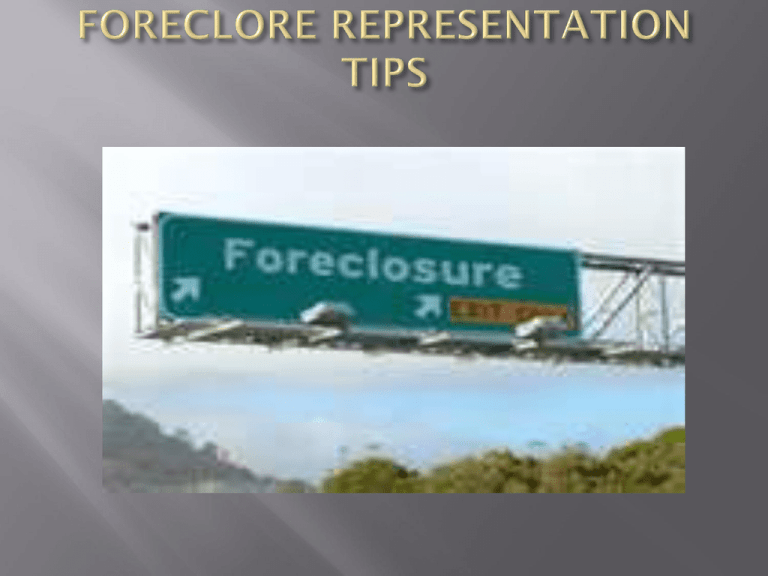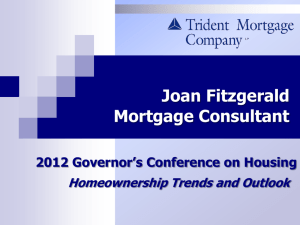PPT - The Miami Valley Fair Housing Center
advertisement

1. 2. 3. Complaint: who is Plaintiff; what is being alleged; what is attached to show have right to foreclose; If no Note, but Plaintiff alleges that it is entitled to enforce Note or is Note Holder, but “unavailable” file Motion for Definite Statement requesting Note to be filed (can do with Mortgage Assignment as well if alleging been assigned Mortgage but “unavailable”). Past Foreclosure filings? 1. 2. Is this a refinance or purchase? Is this a government backed loan? 1. What are the terms? Interest Rate-Fixed or Variable Income (inflated? Fixed income with Variable) Expenses (accurately listed?) Monthly Payments (paying more-any benefit?) When was it dated? Handwritten/Typed versions, different? Signed? Estimates every charge associated with the loan (an associated booklet provided explains charges). *Estimates must bear a reasonable relationship to borrowers ultimate costs. RESPA requires this to be provided to borrower within 3 business days after the lender receives the application. (12 U.S.C. 2603) Signed? If more than one provided, are they different? Are the figures substantially different than HUD-1? Did Client receive within 3 days of application? *Although no private right of action, does provide support for UDAP claims (per se violations) Must clearly, conspicuously and accurately disclose APR, finance charge, amount finance, total loan amount, and payment schedule (15 U.S.C. 1638) Are finance charges less than your calculation 12 CFR Part 226.4 and HUD-1 to calculate . Are payments listed as Monthly? Could do an analysis of APR using listed terms in document Calculate your own determination of amount financed using HUD-1 figures and Reg. Z determine APR. 12 CFR Part 226. Actual APR less stated APR is a violation if outside statutory tolerance (i.e., one-quarter of one percent for irregular loans, oneeighth of one percent for all other closed-end loans-your loan will be a closed ended if total available payments paid out at closing) APR calculations can be somewhat complex, particularly if they involve a variable interest rate based on treasury notes or LIBOR-may want to seek assistance in such an evaluation from Legal Aid or Miami Valley Fair Housing or refer to the National Consumer Law Center “Stop Predatory Lending” manual. Lists all closing costs and payouts at closing. Follow the money, were the funds actually paid? Verify with client whether other listed debts actually paid? Listed Down payment/Earnest money? Credit Cards, Seller’s mortgage, etc. Actually paid or fabricated to make client eligible for loan? Charges listed reasonable? (Particularly amounts paid to broker!) Were there more than one conflicting HUD-1? When was it signed (at closing, at application, never?) Is this a refinance? Was the closing within the last three years? If yes, then: Were two copies provided for each borrower? (Client should have been provided all copies in closing documents) Proper form? (one for new lender, one for same lender) Was the listed cancellation date 3 days after closing? (including Saturday-excluding Sunday and Holidays) If either of the above two apply your client has a right to rescind the loan provided written notice is given within 3 years. --Security interest in property is voided and client’s obligation t o pay finance and other charges eliminated. --Creditor or Assignee has 20 days to refund or credit the amounts paid(including any money given to 3rd party) and to take steps to void the security interest. --Then client must tender back money or property --Can be a complete defense to foreclosure --Statutory damages of $2,000 to $4,000 for failure to respond *****Rebuttable presumption even if client signed receipt******* >Represents the Debt; >Usually considered a Negotiable Instrument under the U.C.C.; >If not a negotiable instrument, is a contract subject to contract principles( Note defines itself as not being a negotiable instrument); >Typically has a waiver of Notice; >Is what allows for personal money damage suit; 1. 2. 3. 4. 5. 6. Does client have a copy, does the lender? Who signed it? Did client understand terms? Significantly different than application? Balloon payment? Pre-payment penalties during first rate adjustment? >Generally Contains Notice and Opportunity to Cure as a condition precedent to filing a foreclosure. This is usually in Paragraph 22; and Right to Reinstate after Acceleration (Paragraph 19?) >Represents an Interest in Land, which triggers Statute of Frauds and Notary Requirements (but Court really doesn’t care if transferred in writing “equitable assignment of mortgage”—PHH Mortgage Corp. v. Unknown Heirs of Cox, 2013-Ohio-4614 (2nd Dist.); >Provides the Foreclosure remedy >IS THERE ONE?? >Who is it from? MERS? >Is it Notarized? >Who signed the Assignment and the Notary? >Are they robo-signers? 1) 2) Need password and I.D. to access images Don’t rely upon lender’s title check Client who had only 50% interest Client whose $175,000 mortgage was released a) b) 3) Evaluate all current mortgages associated with property…. Were they released? Current mortgage assignments? Property in name of Client…other owners? Check for flipping scheme. 1) 2) 3) 4) Get the client’s story 1) a) b) c) d) e) f) g) h) i) Review details of loan, what was told to client, was the closing at their home, late at night, what documents were provided ? Get the details of the closing, who was there, when did it occur, and where, was anything explained, were any representations made (don’t worry about the interest rate increasing, we’ll refinance you in two years). Review the application and the HUD-1 with client. Are the figures correct? Was there a down payment listed when none was paid? Did the client think they were mislead and why? Suggest client start paying into IOLTA-good graces with the judge Has the client attempted any resolution with lender? (Modification, forbearance, etc?) Is there a pending modification application, and if not should there be? (HAMP?? If so pending application should have stayed filing of foreclosure ) Has client filed bankruptcy, what type and when? Discharge or dismissed? Have client contact lender title company and mortgage broker for copies of closing and compare. >What are the Home Owner’s goals? >Keep Home? >Stay as long as possible? >Leave as soon as possible? >What is the Client’s Opinion about the Fair Market Value of their home? >What is the condition of their home? >What is the condition of their neighborhood? >Has any homes sold recently on their street? 1. 2. 3. Knowing this can help form the homeowner’s goals. Can help determine what options the homeowner may have. Determines what consequences a homeowner may face if a foreclosure judgment is entered. 1. 2. 3. 4. Client; Internet searches for values: www.zillow.com; www.realtor.com; www.realistate.yahoo.com/homevalues;www .trulia.com Google Map of area Tax Assessed Value 1) 2) 3) 4) 5) Provides 10 year history of tax assessed value, providing rough idea of value at time of loan. Provides information as to parcel number to focus recorder search Provides photo of house-verify this is the property with client. Are taxes being paid if escrowed? How to contest tax assessed value. 1) Does the Plaintiff have a right to foreclose?-Note Is there an attached note? Did Plaintiff have physical possession of note when the complaint was filed? (HSBC Bank/HSBC Mortgage) C. Was the note negotiated ? i. Is the negotiation suspicious? a. Negotiation done by an agent for a defunct company *Check with secretary of state b. Done by an employee of foreclosing attorney’s law firm *or by attorney c. Several negotiations all signed by same party d. A later discovered/fabricated allonge even though sufficient space on note. D. Was the Plaintiff a non-holder in possession-prove possession at filing with right to collect? E. Be suspicious of all documents miraculously appearing after this issue is raised. A. B. 2. Mortgage a) Was the Plaintiff on the mortgage or was it ever assigned to the plaintiff? b) The magic of equitable assignment-statute of frauds and title issues but not an issue for court. c) Was assignment from MERS and included reference to note? i. MERS cannot hold note so can’t be acquired from MERS ii. Anyone can claim to be V.P. of MERS (form can be downloaded). If truly employee, can request proof of employment and proof of specific authority to act. Particularly if acting as nominee for future assignee. 3. If the Plaintiff is a securitized trust….. a) Mortgage and note must be acquired pursuant to purchase agreement and Pooling and Servicing Agreement-PSA (www.sec.gov/archives/edgar) b) Above agreements usually require note to be negotiated from Originator, to Buyer, to Seller/Depositor to Trustee, with warranties and guarantees accompanied by certifications occurring at each transfer. Mortgage must be included in PSA schedule of Mortgages. c) Only a negotiated note would be acquired by the trust-shouldn’t ever have an unnegotiated note. d) Rarely a qualified mortgage can be accepted after closing date, but must be within two years-if assignment is more than two years after trust closing date, or if mortgage in default….violates trust and REMIC and should be challenged. e) Demand to see original note (might have been destroyed after electronic version created.) f) Challenge any affidavit alleging possession of note by keeper of records/mail clerk. g) Also with most trust we raise State Rico/civil conspiracy claim if criminal features of loan and Fair Debt Collection Practices Act (“FDCPA”), 15 U.S.C. §§ 1692, et sequi based upon non-ownership of note. h) Germans! •Plaintiff’s act of designating itself as “successor in interest” is not enough to prove standing. H&S Financial, Inc. v. Davidson, 2011Ohio-4290 (2 Dist.); • Scrutinize documents in support of standing , such as merger documents. Attaching copies of Merger Documents are not selfauthenticating. Bank of America N. A., v. Miller, 194 Ohio App. 3d 207 (2 Dist. ). Federal Home Loan Mortgage Corporation v. Schwartzwald, 134 Ohio St.3d 13, 2012 Ohio 5017. Question now is: Does the Plaintiff need to have an interest in both the Note and Mortgage Or in just one of them to invoke the jurisdiction of the court? Many appellate cases are interpreting Schwartzwald as requiring either rather than both. Second District has not ruled on this (as far as I can tell). Interesting First District Case that bases standing on answering the question is the Plaintiff the party who suffered the injury. In this case, HSBC was assigned the note along with the mortgage in a mortgage assignment. Court found since both the note and mortgage reference each other this assignment was sufficient. But main thing is asking to whom the damages for the breach will flow. 2013-Ohio-4220 “may be raised at any time during the pendency of the proceedings” as used in Schwartzwald when citing to another case is being interpreted as providing a limit to when standing can be raised. If case over, cannot raise since the pendency of the proceeding is over. Some recent cases do not view the lack of standing as involving subject matter jurisdiction. FAIR DEBT COLLECTION PRACTICES ACT 15 U.S.C. 1692 Glazer v. Chase Home Finance, 704 F.3d 453, 461 (6th Cir. 2013) (Foreclosure is debt collection) If cannot show have right to collect note debt and to request foreclosure, allege: At all times material, Plaintiff is a “debt collector” as the term is defined under 15 U.S.C. §1692a(6 ); And at all material times, the Note debt is a “debt” as defined under 15 U.S.C. §1692a(5); Plaintiff violated the Fair Debt Collection Practices Act when it filed a Complaint in Foreclosure against the [homeowner] because it is threatening to take a legal action that it cannot legally take. 15 U.S.C. §1692(e)(5). Plaintiff does not have the legal right to collect on the Note debt and to Foreclose; Put facts in, example of facts: In order to collect on the Note debt and to bring a foreclosure action, the Plaintiff must be entitled to enforce the Note and have an interest in the Mortgage; Here, Plaintiff is not entitled to enforce the Note and does not have an interest in the Mortgage; Plaintiff is not the Note holder and is not the Mortgagee as it alleges; To be a Note holder, the Plaintiff must have possession of the original Note, along with an endorsement; [Homeowner] has never executed a Note in favor of Plaintiff and the Note has never been endorsed in blank or specifically to Plaintiff; Also, Plaintiff is not the Mortgagee; [Home owner] has never executed a Mortgage in favor of the Plaintiff and Plaintiff has never received an interest in the Mortgage; The chain of Mortgage Assignments was not signed by an authorized party and contains a defective acknowledgment; The Statute of Frauds requires that an interest in land be transferred in writing and signed by an authorized party; A Mortgage is an interest in land; Any attempted transfer of land that violates the Statute of Frauds is void; Ohio and Florida law require that any granting of a mortgage interest be acknowledged by a Notary Public. Here, the Notary Public’s acknowledgement was not valid. The Notary Public did not actually witness Crystal Moore sign. Therefore, Plaintiff violated the Fair Debt Collection Practices Act when it filed a Complaint in Foreclosure. As such, the [Home Owner] is entitled to an award of actual damages plus up to $1,000, to an award of costs, attorney fees, and punitive. 15 U.S.C. §1692(k); McCollough v. Johnson, Rodenburg, & Lauinger, L.L.C., 637 F.3d 939 (9 Cir. 2011). Ohio Rev. Stat. §5301.01 (2008); Fla. Stat. §117.107(9)(2009). EMOTIONAL DISTRESS IS ACTUAL DAMAGES: RECENT 9TH CIRCUIT CASE JURY AWARDED PLAINTIFF $250,000 Here: McCollough testified as to the adverse impact of being sued by JRL, including the anxiety, stress, and anger that he felt and the "down time" and severe headaches that he suffered as a result. McCollough testified that the lawsuit JRL prosecuted against him "definitely" caused him anxiety, increasing his temper, pain, adrenaline, and conflict with his wife. McCollough acknowledged his disabling pre-existing condition but characterized the impact of JRL's lawsuit on him as "the straw that broke the camel's back." He thought that the lawsuit was "frivolous" and "an insult," and that he was "being shoved around." We thus must conclude that the award was not based on speculation and guesswork, but rather on the jury's valuation of McCollough's emotional distress. Think how would show this damage to jury—have to have client start documenting and may have to hire expert to show emotional damages(this costs $) 1. Failure to provide notice of default and opportunity to cure (if in mortgage terms) (condition precedent) 2. Statute of Frauds bars Plaintiff from attempting to enforce Mortgage it does not have an interest in writing and signed by an authorized party(not a winner). 3. If married couple and one spouse is not on the Note, did both sign the Mortgage? If did not, then spouse who did not sign would not have a lien on their dower right/legal right(if both on deed) 4. Don’t just go along with Plaintiff’s request to Reform Mortgage. Look at case law and facts of situation first. 5. Right to Reinstate (if in terms) (Contract Violation) 1. 2. 3. Who is entitled to enforce contract? Read the Note and Mortgage terms. Did Plaintiff Mitigate its Damages? Principles of Equity bar foreclosure action Foreclosure two step process: 1) default on obligation; and 2) consider equity of the situation in order to decide of foreclosure is appropriate. PHH Mortgage Corporation v. Barker, 190 Ohio App.3d 71 (Ohio App. 3 Dist. 2010) Court upheld trial court us of equitable principles to reinstatement of homeowner’s loan, because the homeowner made a good faith effort to reinstate, but Plaintiff obfuscated the situation making it impossible for the homeowners to do so. Others: Contract violations , Estoppel, and Unjust Enrichment 1. National Fair Housing Goals, 42 U.S.C. § 1441 “the realization as soon as feasible of the goal of a decent home and a suitable living environment for every American family . . .” 2.Federal Housing Administration, Rural Housing Service, and Veteran’s Administration loans all have loss mitigation regulations that must be followed. Failure to follow these results in the plaintiff failing to comply with a condition precedent and the case must be dismissed. Example is FHA’s face to face requirement. 1. 2. 3. 4. 5. Is Plaintiff or Servicer a TARP recipient? If yes, under HAMP regulations. HAMP regulations prevent a foreclosure from being filed if homeowner is in the process of being reviewed for a HAMP loan modification and prevents Plaintiff from going forward on Sheriff’s Sale if under HAMP review. Can use contract principles and equitable claims if fail to comply: breach of contract; promissory estoppel; intentional infliction of emotional distress. Corvello v. Wells Fargo Bank, N.A., 9th Circuit Federal case (August 8, 2013): If homeowner completes trial period plan, bank must offer permanent loan modification. Can be used to contest allegation of default if entered into loan modification and to get information about loan payments. Under the Real Estate Settlement Procedures Act (RESPA) 12 U.S.C. §§2601-2617, before January 10, 2014, the lender/servicer has 20 days to acknowledge receipt of the request (unless the action is taken within that time period) and 60 days after receipt to (1) make appropriate corrections in the account of the borrower; or (2) after conducting an investigation, provide borrower with a written explanation or clarification, including reasons why account is correct and name and telephone number of person who can assist borrower. After January 10, 2014, the QWR is split into two categories: Notice of Error (Federal Regulations §1024.35) and Request for Information (Federal Regulations §1024.36). Servicer has 5 business days to acknowledge request or notice of error and 30 business days to respond. Servicers can request a 15 day extension if notifies borrower of the extension and the reasons. Failure to comply provides individuals with actual damages as a result of the failure and any additional damages, as the court may allow, in the case of a pattern or practice of noncompliance, in an amount not to exceed $1000 (before January 10, 2014) not to exceed $2000 after January 10, 2014. Reasonable attorney fees may be awarded as well. See: Attachment 2, an example of a QWR (used before January 10, 2014). If Plaintiff has filed a foreclosure action two times before and the Plaintiff dismissed the past two foreclosures under Rule 41(A)(1), the second dismissal is considered to be dismissed with prejudice and the third action is not allowed. Exception: If homeowner “cured” the default or had the loan reinstated before the third foreclosure action. U.S. Bank v. Gullotta, 899 Ohio St.3d 399 (Ohio 2008); Note: Plaintiffs are attempting to get around this rule by moving the Court to dismiss the foreclosure under Rule 41(A)(2). Under (A)(2), the Court is suppose to only dismiss “upon such terms and conditions as the court deems proper.” “Proper” means Plaintiff asked, I would think. Plaintiff’s claims are barred by the Defendants’ Constitutional right to Due Process. The Court’s facilitation of a process that allows for property to be taken away by an entity that has failed to show that it has legal right to do so, violates the homeowners’ United States Constitutional due process rights and their Ohio Constitutional Inalienable Rights. U.S. Const. am.14; Section 1.01, Art. I, Ohio Constitution. 1. 2. 3. 4. 5. 6. 7. Appraiser licensed in Ohio (after 1/07)?* Real Estate Agent licensed in Ohio?* Mortgage Broker licensed in Ohio?* Seller? Lender? Assignee?(hopefully not a holder in due course if assignment occurred after default) MERS? Question often comes down to “who has money”? Also issue of too many parties makes settlement and discovery difficult and expensive. (or possible) *Commerce Department has database in Real Estate Division. (Includes disciplinary actions) Can call Financial Institutions Division to check for expired or terminated registrations, and bond information. 1. Truth in Lending Act (TILA) 15. U.S.C. 1601 et seq. 12 C.F.R. 226 (Reg Z) -Creditor(usually original lender) and assignee if not holder in due course or if “violation apparent on face of documents” -Failure to disclose credit information or cancellation rights. Material Violations (grounds for rescission): *Amount financed *Finance Charge *Annual Percentage Rate *Total of Payments *Payment Schedule *Failure to give proper notice of right to cancel *Certain HOEPA violations 2. Home Ownership Equity Protection Act (HOEPA) 3. Real Estate Settlement Protection Act (RESPA) 4. Fair Housing Act (FHA) Home Mortgage Disclose Act Data (HMDA) for loan application by lender and applicant’s race, income and geographical location. 5. Equal Credit Opportunity Act (ECOA) 6. Fair Credit Reporting Act (FCRA) 7. Racketeer Influenced and Corrupt Organizations Act (RICO) 8.Fair Debt Collection Practices Act 1. Consumer Sales Practice Act (CSPA) (RC 1345) (2 yr. S.L.) 2. Mortgage Broker Act 3. State RICO 1. Breach of Fiduciary Duty 2. Fraud/Appraisal Fraud 3. Aiding and Abetting 4. Fruits of the Fraud 5. Unconscionability/Improvident Lending-lending well beyond borrower’s repayment ability. 6. Unjust Enrichment-reasonable tangible net benefit to borrower? 7. Negligent Misrepresentation-failure to disclose loan carries no reasonable tangible net benefit 8. Intentional Misrepresentation 9. Breach of Contract 10. Civil Conspiracy-Joint Venture-Agency 11. Negligent Infliction of Emotional Distress 12. Breach of Duty of Good Faith and Dealings 13. Recoupment (claims in defense that would be barred if brought affirmatively) 14. Equitable claims (it just isn’t fair) . We have client save a monthly amount that they can afford for the duration of the foreclosure. Can use this money to show court paying mortgage, to negotiate a settlement, for alternative housing, to file bankruptcy, or for emergencies. Can save enough to be able to offer a short payoff or to buy another house. CLIENTS’ REALISTIC GOAL









